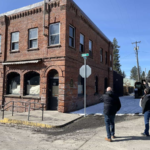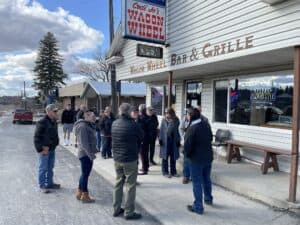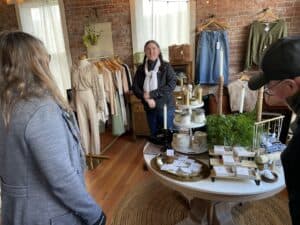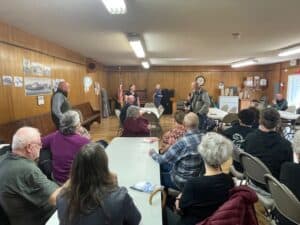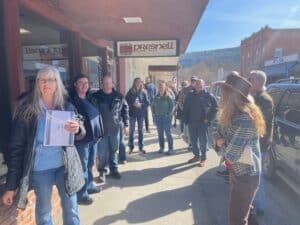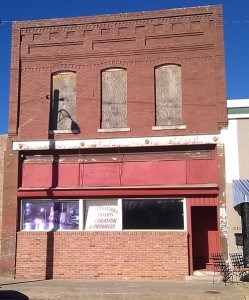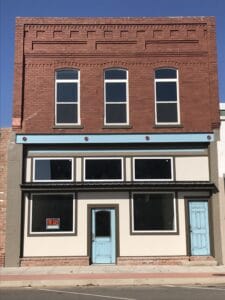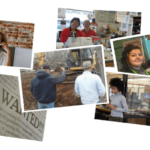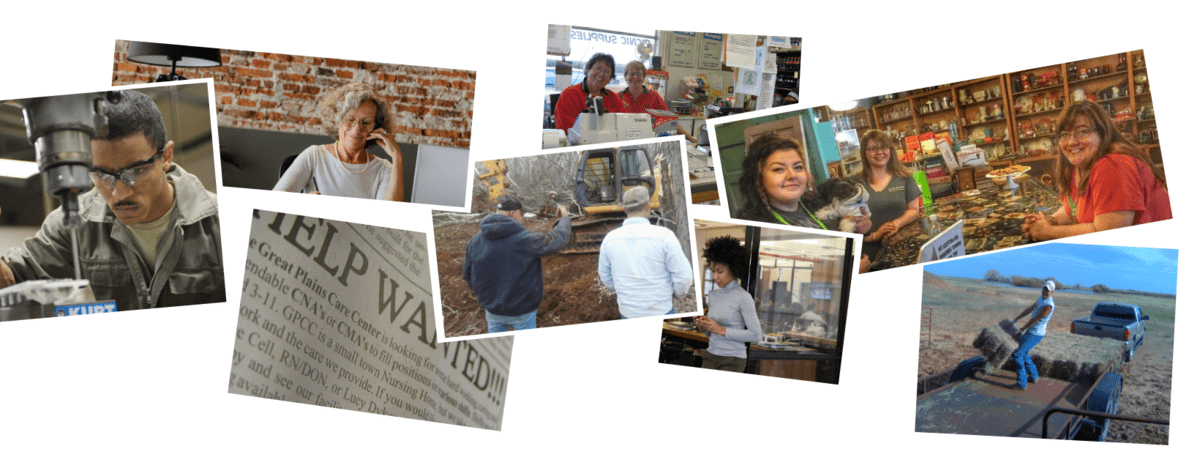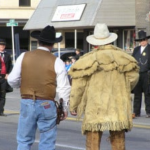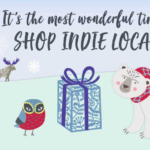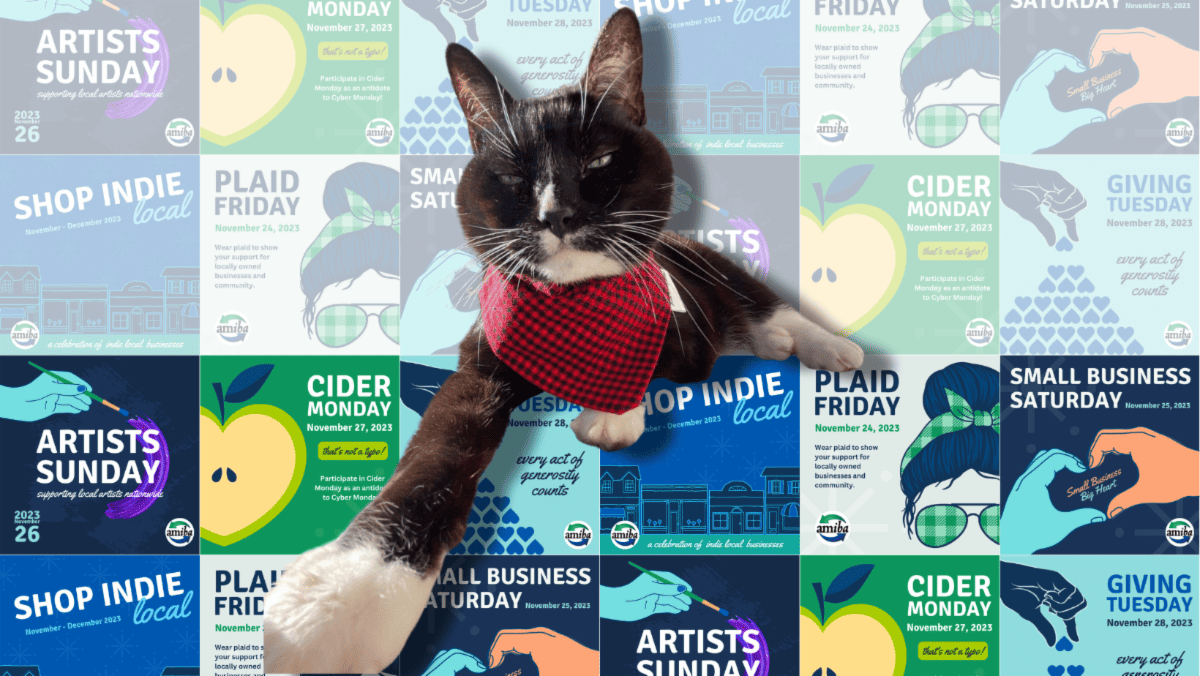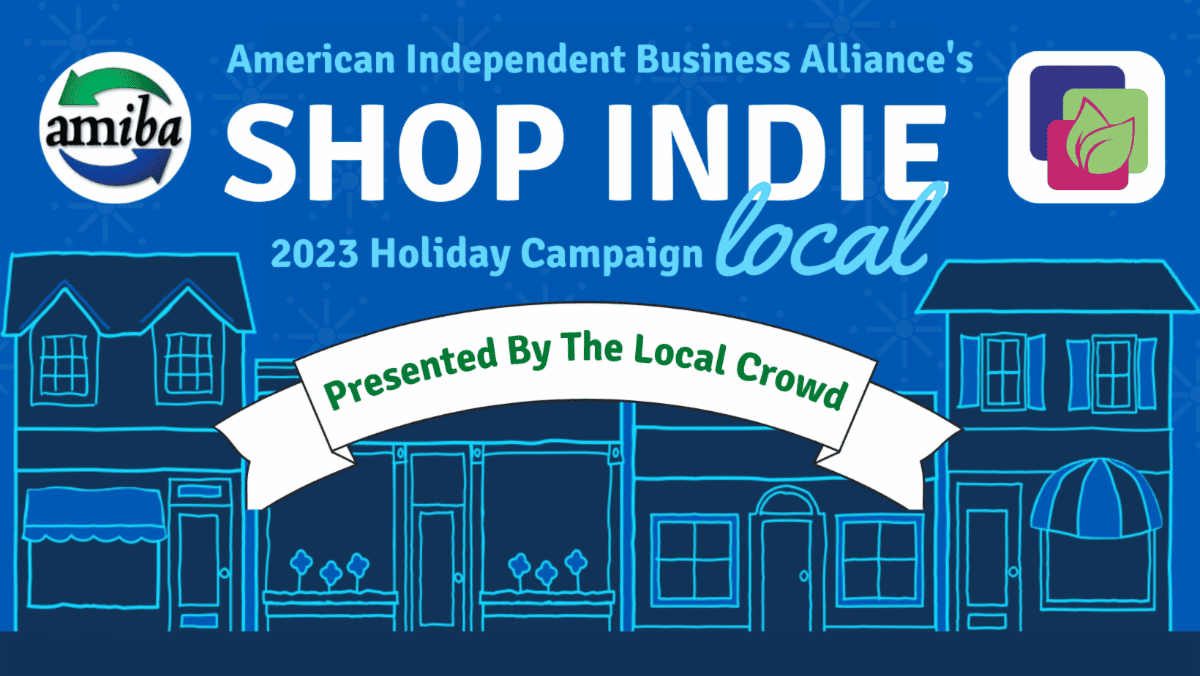Seasonal businesses: post signs year-round
Marketing tip: keep signs up year-round even if you’re a seasonal business. When I toured several small towns in Washington and Idaho with the Inland Northwest Partners, I noticed many part-time and seasonal businesses did not have signs up during their off season. In the town of Deary, Idaho, (population 500) there is a wine […]
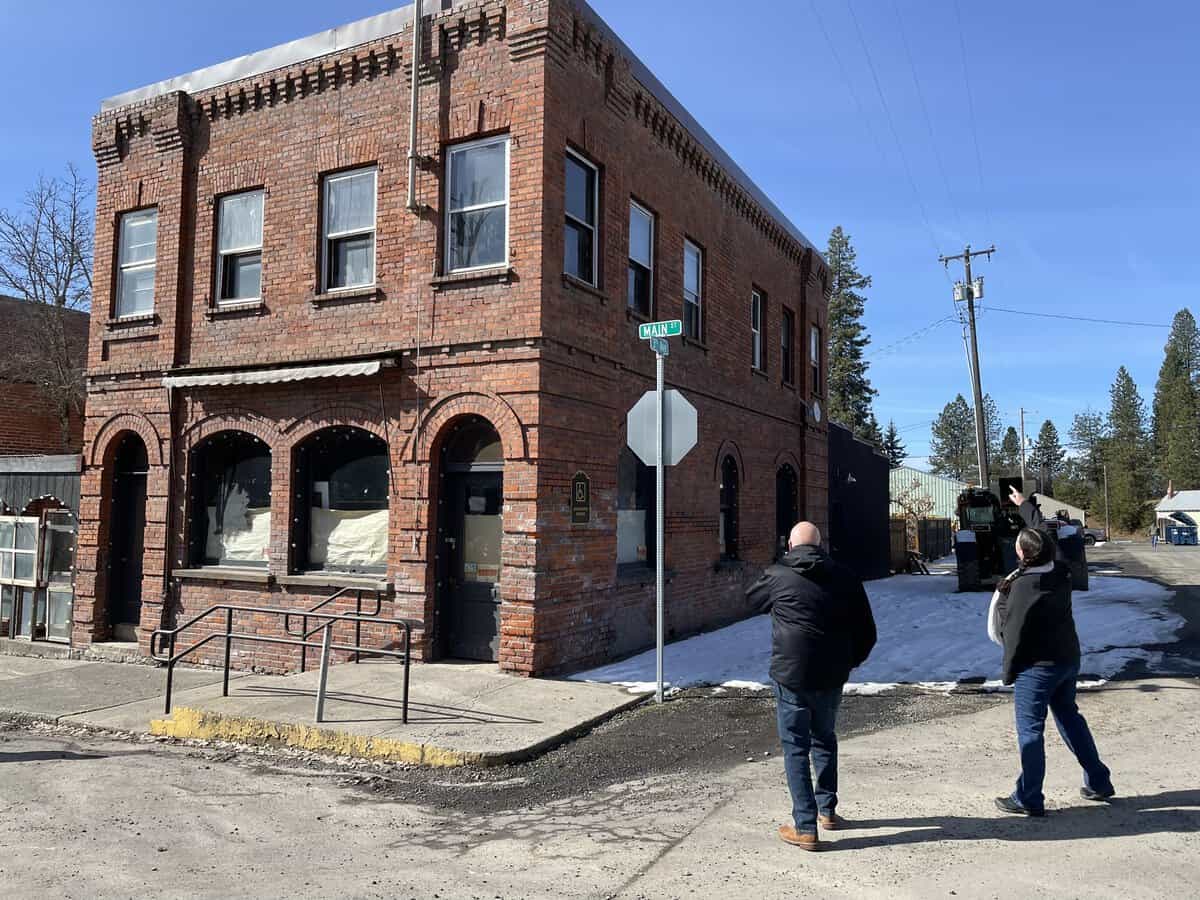
This building looks like it is in good repair, but there’s no way to tell by looking that it’s an active seasonal business. Photo by Ana Blaisdell.
Marketing tip: keep signs up year-round even if you’re a seasonal business.
When I toured several small towns in Washington and Idaho with the Inland Northwest Partners, I noticed many part-time and seasonal businesses did not have signs up during their off season.
In the town of Deary, Idaho, (population 500) there is a wine tasting parlor in a well-kept brick building on a corner in the downtown. Unfortunately there are no signs to indicate that the building is in use as a business during the tourist season. All during the winter it looks like just another empty building with blank paper covering the windows. By the time I toured in March, the paper was water stained and looked unattractive at best.
This contributes to a look of having an empty downtown or being less occupied than it really is. The way your downtown looks affects how people think of your downtown. Looking bad hurts the entire community’s development, which in turn hurts the wine tasting business.
It would be quite easy to create signage that indicates what months during the year the business is open and when it is not, much like operating hours.
I suggested a number of options for the wine tasting room. The owners could paint decorations on the windows, hang a permanent sign on the building, put posters or artwork inside the building to show through the windows, or use perforated decals with the marketing message and keep people from looking through the windows while still admitting light to the interior.
This tip applies to seasonal service businesses just as much as retail businesses. Whether your business is seasonal tourism equipment rentals or tax-season accounting, keep signs up year-round so you don’t look abandoned.
Every business in a small town wants to be part of a thriving local economy. Posting signs year-round on your part-time seasonal business is one way to contribute to that thriving locally economy.
Does your town need a boost of enthusiasm and fresh ideas?
Learn more about my working visits to small towns here.
Learn more about my working visits to small towns here.
These small town neighbors bought vacant buildings, brought them up to code. Here’s what happened next
Waynoka, Oklahoma, had a lot of vacant run-down buildings in their downtown. In a town of 900 people, the prospects didn’t look great. At an all-class reunion, a group of alumni got together and decided to change that. They called themselves Project Waynoka, our friend and early contributor Jeanne Cole said. They started raising money. […]
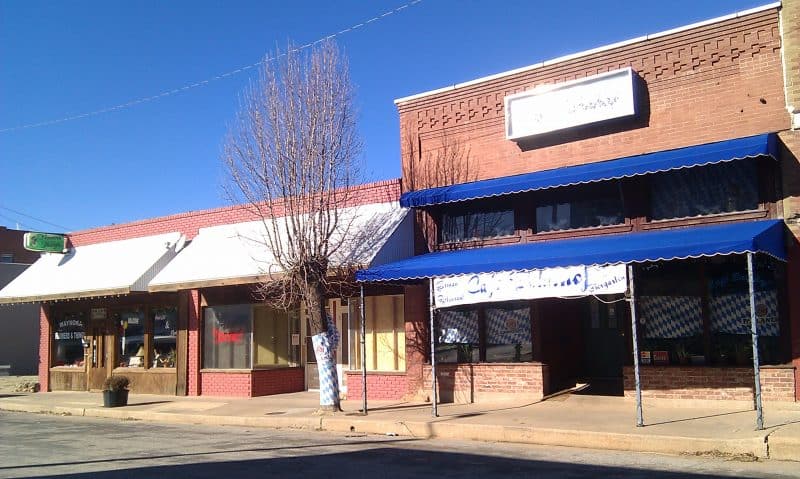
What can small towns do about crumbling buildings in their downtown? They can join together to fix them up and get businesses in them. Our own Jeanne Cole helped to bring this building back in downtown Waynoka. Photo by Becky McCray.
Waynoka, Oklahoma, had a lot of vacant run-down buildings in their downtown. In a town of 900 people, the prospects didn’t look great. At an all-class reunion, a group of alumni got together and decided to change that.
They called themselves Project Waynoka, our friend and early contributor Jeanne Cole said. They started raising money. They bought one building. They raised more money with community events. They scrounged for materials. They rallied volunteer labor. They brought this one building up to code, then sold it.
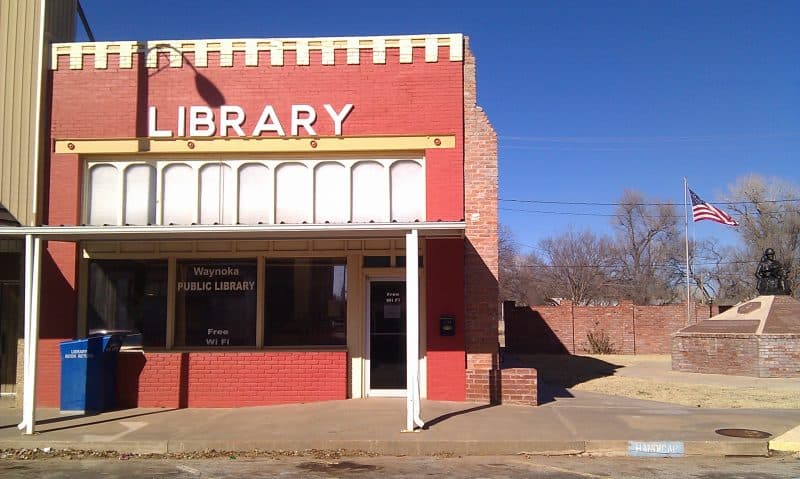
The public library in Waynoka is housed in a building that Project Waynoka rehabilitated. Next door is a vacant lot that the library uses for event space and that features a veterans memorial. Photo by Becky McCray.
With that money, they bought another building. More work, more fundraising, even more work, and there’s another building brought back into productive use.
They just kept saving buildings. Buildings that now house locally-owned businesses. The public library. The popular German restaurant.
A few buildings turned out to be in such bad shape that demolition was the best choice. So they took them down and then cleaned up the empty lots.
After decades of working on the project, the volunteer momentum had run down a bit. One key source of low cost labor was no longer available. But they didn’t quit entirely, they just slowed down.
They took on a big challenge with the old American Legion building. It needed a lot of work. They started with cosmetic improvements to the exterior.
It’s a model that any town can borrow: a small group of people rallying the community to save downtown buildings.
A group of Minneapolis neighbors who did a similar thing, with the added bonus of building cooperatives and nurturing local businesses as part of their project. Read more about it here: These Neighbors Got Together to Buy Vacant Buildings. Now They’re Renting to Bakers and Brewers
Chris Miller, of Adrian, Michigan (pop 21k), told me by email that a group of 22 local investors had pooled resources and bought a downtown building. You can read about it in this report: https://mml.org/placemaking/wp-content/uploads/sites/2/2013/12/casestudy-main-street-adrian.pdf
So that’s one by a private foundation, one by cooperative, and one by LLC.
Beyond the Big Banks: How rural small businesses can Move Their Money locally
The “Move Your Money” campaign wants you to shift your financial resources to local banks and investment opportunities. That makes a lot of sense for small town businesses who care about having a thriving local economy. The 2024 Move Your Money Campaign The American Independent Business Alliance (AMIBA) has been at the forefront of the […]
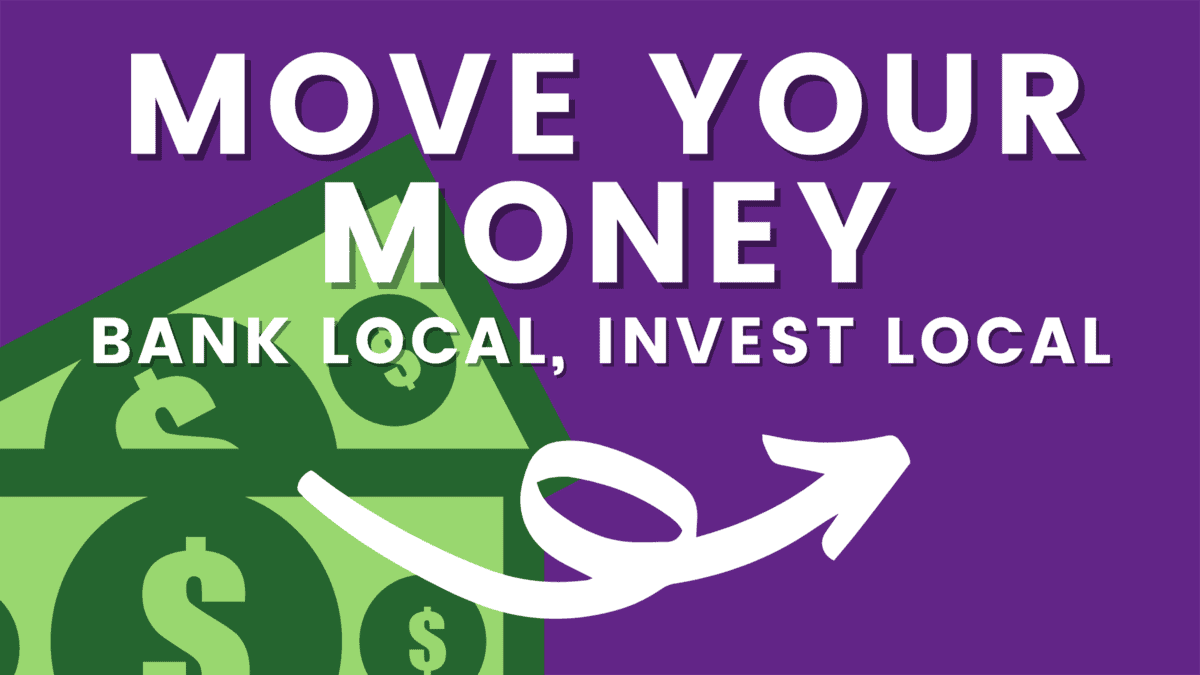
The “Move Your Money” campaign wants you to shift your financial resources to local banks and investment opportunities. That makes a lot of sense for small town businesses who care about having a thriving local economy.
The 2024 Move Your Money Campaign
The American Independent Business Alliance (AMIBA) has been at the forefront of the “Move Your Money” campaign, offering resources and support for those interested in making the switch to local banking. This year, AMIBA has emphasized the critical role that local banks and credit unions play in fostering economic resilience within small towns and rural communities. By banking locally, businesses and individuals not only enjoy more personalized service but also contribute to a financial ecosystem that directly benefits their immediate environment.
Key Points for Rural Small Businesses
For rural small businesses, the decision to bank locally can have far-reaching implications. Here are some practical benefits from moving your money:
- Strengthening Local Economies: Every dollar deposited in a local bank or invested in a local business circulates within the community, amplifying its economic impact. This circulation helps to create jobs, fund local projects, and support the growth of other small businesses.
- Access to Tailored Financial Services: Local banks often have a deeper understanding of the unique challenges and opportunities faced by rural businesses. This insight allows them to offer more tailored financial products and advice, which can be crucial for businesses looking to navigate the complexities of rural economies.
- Building Community Connections: Banking locally facilitates relationships that go beyond mere transactions. It fosters a sense of community and mutual support, where businesses and banks work together towards common goals.
- Advocacy and Support: AMIBA and other organizations provide a wealth of resources for businesses interested in moving their money. From virtual screenings that explore cooperative economies to discussions on local investing, these platforms offer valuable insights and networking opportunities.
How local is your bank?
As rural and small town banks merge and change, it can be tough to tell if your once-local bank really is still local. With regulations pushing small town banks to buy other small banks, your bank now might be semi-local or owned somewhere else. But does that make them a bad neighbor?
Even regionally owned banks are better for your community than giant national or international banks. Here are some practical ways to decide just how local your local bank acts.
- Check the current ownership structure: Look for information about the bank’s ownership structure on their website or by contacting the bank directly. Community-owned banks are typically owned by share-holding local residents, while regional or commercial banks may be owned by larger corporations or shareholders from outside the community.
- Research the recent history: Local banks often have a long history in the community, but may have shifted priorities if ownership changed. Check the bank’s website or media stories for information about its recent community-focused initiatives.
- Visit the local branch: Visit in person to get a sense of the bank’s community involvement. Look for local causes featured in the lobby. See what local ties are visible.
- Ask for recommendations: Reach out to other local businesses, community leaders, or residents to ask for their recommendations on local banks. They may have personal experiences or insights that can help you make an informed decision.
How to move your money
Check the checklist in Move Your Money and Bank Local.
Advocate for Local Banking
Catch up with additional local banking resources from the Institute for Local Self-Reliance.
The “Move Your Money” campaign is more than just a call to action; it’s a movement towards sustainable, community-focused banking. For rural small businesses, the benefits of participating extend beyond financial gains. It’s about building a resilient local economy that can withstand the ebbs and flows of the broader financial system.
2024 Survey of Rural Challenges Is Open!
These 10 questions will provide information to many organizations and people on what is challenging for rural communities. Are you rural? This survey is for you. SmallBizSurvival.com and SaveYour.Town are conducting the 10th-anniversary edition of the Survey of Rural Challenges! Take the Survey of Rural Challenges. Spread the word Could you help us spread the word on […]
These 10 questions will provide information to many organizations and people on what is challenging for rural communities. Are you rural? This survey is for you.
SmallBizSurvival.com and SaveYour.Town are conducting the 10th-anniversary edition of the Survey of Rural Challenges! Take the Survey of Rural Challenges.
Spread the word
Could you help us spread the word on the Survey of Rural Challenges to as many people as possible? You could repost, add to your newsletter, print it in the local newspaper or share in meetings and presentations now through the end of May 2024.
Share this link to share the survey: https://saveyour.town/survey2024
Why you want to take the Survey
Your answers to the Survey of Rural Challenges will:
Prepare better services for rural communities.
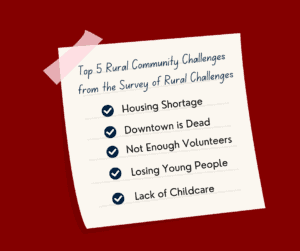
2023 Top Five Rural Challenges
“It gives us great insight as we continue to refine our services geared toward small rural communities.” Marci Goodwin from Peoria IL said on LinkedIn
Help others to know what the real issues are in rural communities.
“As we work to listen and then tackle these important issues, data like this is extremely helpful. “Jason Duff
Assist those working in rural to make changes that will matter.
“I am experimenting with an organizational pivot towards expert entrepreneur coaching for rural co-operatives’ rural businesses and away from supporting written business plans. Your survey results and our conversations helped me clarify how we describe that.” Heather Hallgrimson, Saskatchewan, Canada
Have results that will help other organizations address the needs of rural people.
“Save Your.Town and Small Biz Survival’s Survey of Rural Challenges noted Rural business people needed help with marketing, starting a business, or receiving economic development incentives.” American Indian Alaska Native Tourism Association
“Lack of housing, inactive downtowns, population losses, losing young people, and childcare ranked the highest as rural community challenges. What are the next steps we need to take in Casselton (besides the grocery store because I know that’s what you’re going to say and the need for a grocery store is a given)?” Char Gust, Casselton City Council Member
Direct the conversation in important ways.
“If you care about rural people and places, this is a good opportunity to share your thoughts and help inform the conversation.”Tyson Ochsner, Professor at Oklahoma State University
“We use the results to create practical steps that help you shape a better future for your town. Because you tell us what topics rural people most want help with, your responses also get shared out to others who work with rural communities and in articles and media stories,” said Becky McCray, cofounder of SaveYour.Town
Take the Survey of Rural Challenges today!
How the survey works:

Communi-Tea from Estherville News
The survey will collect voluntary responses online in the 1st and 2nd quarter of 2024. The survey is open to rural people globally: USA, Canada, Australia, New Zealand, or any other country. Anyone who lives or works in a small town can answer. More than 1700 people answered the survey in previous years. Results from 2015, 2017, 2019, 2021, and 2023 and links to media coverage are available at https://saveyour.town/survey-of-rural-challenges-news
Helping us get more survey responses gives you more to do with the survey later.
Amy Peterson, Estherville News (Iowa) said,“Our newspaper used the Survey of Rural Challenges as a starting point to do some interviews with local people about their challenges. Our series earned second place as Best Series in the Iowa Newspaper Association awards. I love the Survey of Rural Challenges as a journalist, and we’ll have to find a new way to use the numbers to take the pulse of our community.”
Amy started the series Spilling the Commun-tea in the local paper.
Take the Survey of Rural Challenges today!
Improving the rural workforce: small town stories and takeaways
Takeaways for improving rural workforce: Bring together students, employers and multiple levels of education Build and document employee skills with micro-credentials Use apprenticeships to build skills, increase awareness of local job options Stitch together multiple programs to build your own workforce To add a new program in the public schools, hire dedicated program staff (at […]
Takeaways for improving rural workforce:
- Bring together students, employers and multiple levels of education
- Build and document employee skills with micro-credentials
- Use apprenticeships to build skills, increase awareness of local job options
- Stitch together multiple programs to build your own workforce
- To add a new program in the public schools, hire dedicated program staff (at least part time)
At the Teeny Tiny Town Summit held in Woodward, Oklahoma, a panel of local people addressed rural workforce challenges and what actions they were taking to address them.
The panelists were
- Barclay Holt, High Plains Technology Center, Woodward, Oklahoma
- Joe Cox, Oklahoma Works at Oklahoma Department of Commerce
- Brad Griffiths, Oklahoma State Regents for Higher Education
- Liz Leaming, Ponca City Development Authority, Ponca City, Oklahoma
And I’ll share some additional information from:
- Roger Knak, Fairview Regional Medical Center, Fairview, Oklahoma
Bring together students, employers and multiple levels of education
To encourage local students to consider additional local career options, High Plains Technology Center offers TAP (Technical Applications Program) for sixth through 10th graders, Barclay Holt said. The project is for career exploration that leads into the full-time training programs at HPTC. Think hands-on welding, tool and equipment use. All of the kids get to see and participate in all of the education areas. It is held at Woodward schools in their existing buildings, and at other schools across the HPTC district.
This brings together the two levels of education (career tech and public schools) in a way that didn’t require a lot of new investment. They also partner with community leaders, business owners, and parents.
Build and document employee skills with micro-credentials
Brad Griffiths explained UpskillOK.org, a micro-credentialing program of the Oklahoma State Regents for Higher Education. It offers a different way to approach employee training and development. Employers can collaborate with Oklahoma colleges and universities to develop a standardized credential for specific career skills. Other states and territories offer similar programs.
Just a few examples from the hundreds of current micro-credentials include:
- Government and Not-for-Profit Accounting
- Artificial Intelligence – Game Developer
- Mechanical Design
- Court Reporting Skills
Many of these also connect to industry certifications, like Google Career Certificates and CompTIA.
Higher education tends to measure courses in credit hours, and these micro-credentials include nine credit hours. These are smaller than the university certificates offered at some institutions, which take more hours. Micro-credentials can include learning through activities and projects, so they’re looking to connect with apprenticeship programs for work-based learning.
Use apprenticeships to build skills, increase awareness of local job options
Oklahoma Works Joe Cox has worked with local employers across the state to start apprenticeship programs in local businesses. When he started, most existing apprenticeships were in Oklahoma City or other metro areas. He has worked to expand to rural communities, including Watonga, Oklahoma.
He said it is a program that takes someone not necessarily fully qualified and gives them a chance at employment. The program has 97% retention rate. The apprenticeship can be a one to four year program. Cox often connects employers with the Oklahoma Department of Rehabilitation Services to help their clients connect with apprenticeship jobs.
Connecting students to existing local employers and jobs helps increase the chances to retain young people in rural communities.
Stitch together multiple programs to build your own workforce
Roger Knak with Fairview Regional Medical Center, Fairview, Oklahoma, presented on the health care panel, and he addressed how they build their workforce. Because they employ people in a variety of fields, they have to work with multiple workforce programs to grow their employees’ skills.
- They provide stipends to support their nurses with lower level CNA certification to complete their higher level LPN degrees.
- For their IT needs, they have a paid internship to work with their full time IT staff person.
- Their lab technicians complete online training through Barton County Community College from Kansas.
Roger told me that he wasn’t aware of the Oklahoma Works apprenticeship programs until this event. He planned to check how he could connect his IT internship to the state program. That is the power of holding local events and encouraging local networking.
Grow your own workforce
Ponca City, Oklahoma, has created multiple workforce programs. Liz Leaming from Ponca Works talked about growing their own workforce.
Ponca Works connects high school seniors who do not plan to attend college with local employers. Once per month all year the seniors meet with representatives from employers for Cookies and Careers. This encourages students to pursue local employment even if they don’t plan on college.
Ponca Works also uses augmented reality to give tours of local companies in a safer way. Some workplaces may not be set up for large group tours, or may have dangerous equipment. Using AR, students can get a virtual experience without compromising their safety.
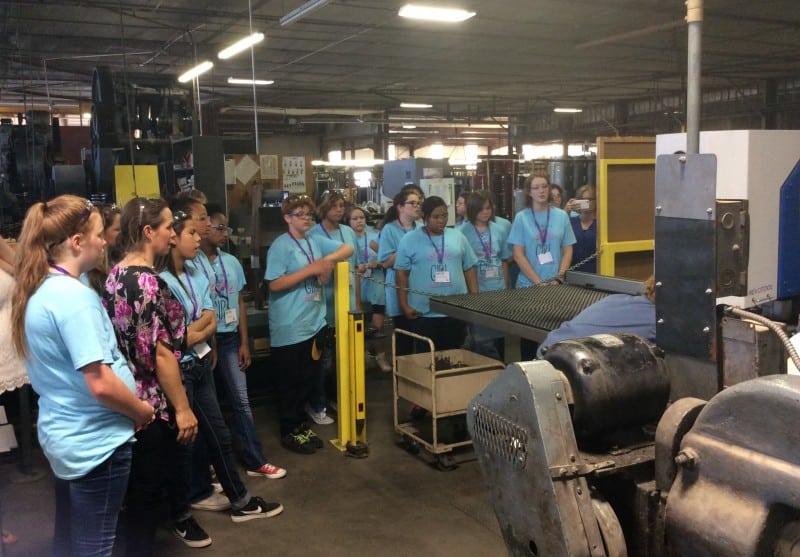
Some workplaces can be toured, like Lindsey Manufacturing, maker of central vacuum systems. Other workplaces are safer to tour by Augmented Reality instead. Photo courtesy of Ponca City Development Authority.
Ponca City also offers a Girl Power STEAM camp. Here is how they explained the origin of the project:
When Ponca Works began there was a job posting for an office position with about 100 applicants, all female. At the same time there were dozens of jobs in the technical field that were open. It wasn’t a surprise, but more of a wake up call, at the large gap of girls and STEM careers. Girl Power exposes middle school girls to strong women with STEM careers in our community, hands on activities that teach exploration in science, technical skills, problem solving, critical thinking, and much more. We also tour facilities in Ponca City that offer careers in those fields. Our first campers will be entering the workforce next year, and we are excited to see what they are choosing to pursue.
Ponca Works also led a project to standardize all education and career players on a single evaluation tool so students could be evaluated once and move through any of the local workforce programs.
Liz mentioned that lots of kids are interested in forensic science, but it is a massively under-employed field with no direct employment opportunities locally. Drawing on similar skills, some students have been redirected into microbiology jobs which are available locally, such as the local manufacturer that needs lab analysis for their animal food supplements.
The Ambassador Program at Ponca Works trains younger employees at local businesses to share their story of local career opportunities with high school students.
To add a new program in the public schools, hire dedicated program staff (at least part time)
Ponca Works also offers a Wildcat Internship for juniors and seniors in high school. Students spend 1 to 3 hours a day at an employer. Around 30% of those students are paid. At the end of the program, around 10% get hired. There are 108 participating this year.
Before they hired a dedicated staffer at the schools, internship enrollment lagged. People at the school simply did not have capacity to manage yet another program.
Actions for rural employers to build their local workforce:
- Establish apprenticeship and internship programs: Apprenticeships and internships can help build skills and increase awareness of local job options. Look for state programs and projects to build support for internships and apprenticeships.
- Connect with multiple workforce development programs: Employers can provide stipends for employees to continue their education, connect with higher education micro-credentials and partner with educational institutions across geographic boundaries for specialized education.
- Engage with local schools: Employers can partner with local schools to offer programs to help students gain hands-on experience in various fields. Connect with high school seniors who do not plan to attend college and offer them employment opportunities. This can help retain young people in rural communities.
- Promote STEAM education: Employers can support local initiatives, camps, and programs that exist in the community.
- Hire dedicated program staff: If adding a new program in public schools, it’s important to hire dedicated program staff to promote the program effectively.
- Standardize evaluation tools: Work with educators and career specialists to agree on a single evaluation tool so students can take a single evaluation to use at any of the programs.
- Engage in local networking: Employers can participate in local events and networking to learn about new programs and opportunities.
More resources
- Grow Your Own Workforce, Katherine Long, CEcD, Ponca City Development Authority
- Reaching “at risk” kids for local jobs, two real-world examples, SmallBizSurvival
- Finding Good Employees: Rural Workforce Trends video, SaveYour.Town
99% of the best things you can do for your town don’t require anyone’s permission
Building community in your small town sounds like a daunting task. It’s easy to get bogged down, thinking there’s too much to do, that you’d need too many permissions or it would take too much money. The reality of building community is it’s a change of mindset to Take Small Steps. 99% of the best […]

Building community in your small town sounds like a daunting task. It’s easy to get bogged down, thinking there’s too much to do, that you’d need too many permissions or it would take too much money. The reality of building community is it’s a change of mindset to Take Small Steps.
99% of the best things you can do for your town don’t require anyone’s permission.
I’ve seen lists before of things you can do for your city, but none written for small towns. Let’s fix that. Here are 100+ small-town-approved ideas to build community.
- Hang out downtown, in the park, in plazas and pocket parks. Take a book or a snack. Invite friends. Have conversations.
- Cook extra and share with a neighbor.
- Introduce yourself when meeting someone new.
- Smile and remind people of your name.
- Walk. Park and walk to run errands. Park further from where you want to go.
- Hold a (music) jam session in your neighborhood or downtown.
- Bike. Bike your errands. Bike to work. Bike to the park.
- Make a list of everything in your town you can walk or bike to in 30 minutes. You might be surprised.
- Attend the arts and music events at local schools and colleges.
- Go to community performances and events. Cheer. Share praise online.
- Eat outside at local cafes and at picnic tables and benches downtown.
- Sit down for a meal with someone not like you. Someone from the community who is from a significantly different background, ethnicity, class, income level, or education. Listen.
- Spend more time in your front yard and on your front porch.
- Dress the front of your house to be inviting. Set out extra chairs and invite friends to join you.
- Drop in on the library and ask about what they have besides books.
- Start a hashtag for sharing good news and ideas in your town. Comment, like and share good things.
- Take pictures of things you like in your town and share them online.
- Shop the farmers’ market. Try something. Share pics online of what you cook.
- Walk into a local store. Take 5 friends. Spend $10 each.
- Walk into a local store. Take 2 pictures of something you didn’t know they had for sale. Post online.
- Start or join a walking or running group.
- Make and share a list of every public walking trail or meditation path in your town including those in parks, on church grounds, at schools or colleges, and along public waterways.
- Enter something you’ve created or grown in the county fair.
- Start a community betterment group. Pick items from this list or make up your own ways to improve your town.
- Plant a tree.
- Plant flowers in unexpected places.
- Dig and divide plants and put the new plants where others can see and appreciate them. Ask neighbors if they have plants you can divide and share.
- Start a positive hashtag for your community like #IfOurTown (#IfAlva or #IfPullman) and post positive things with it.
- Participate in art walks, downtown strolls and evening events.
- Hang string lights.
- Start a rock hunt. Find some small rocks, paint them and hide them outdoors downtown. Make a hashtag or online group so people can post photos when they find them.
- Plant an extra row in your garden to share.
- Grow a community garden with neighbors.
- Set up a table in a public place or at a farmers market to give away extra produce.
- Donate extra produce to the food bank.
- Put googly eyes on something. Use non-destructive adhesive like poster tack.
- Talk to your neighbors.
- Lead a photo walk. Invite friends to walk around and take pictures of good things. Notice things you like and share them.
- Host a street dance. Or empty lot dance or parking lot dance or…
- Start a sing-along. Anywhere, anytime.
- Wash the outside windows on an empty building.
- Pull weeds from public flower beds and boxes.
- Shovel snow for a neighbor.
- Talk to young people. Ask about what they want in your community.
- Sweep your own sidewalk.
- Find something that needs a simple repair, like a wooden flower box or a loose board on an empty building. Repair it.
- Work outdoors. Take your laptop for coworking in the park or at tables downtown.
- Carry a small trash bag when you walk or run to pick up trash.
- Send written thank you cards and letters to people who do good things in town.
- Start a Coffee and Calendars gathering. Invite people for coffee and ask them to bring the calendars and plans for any groups, organizations or boards they work with. Share community events and plans with each other.
- Make a cardboard playground. All you need is cardboard, scissors, tape, random material and stuff, and kids.
- Host a pop-up business from a local crafter or artist in a building or business you own.
- Plant herbs in empty flower boxes or pots.
- Paint a temporary mural on cloth, cardboard, coroplast (plastic sign material), or sheet metal. Hang it using magnets, sticky tack, or bungee cords.
- Put up directional signs to all kinds of things: parks, murals, art, businesses.
- Use your town’s waterfront, creek, lake or river. Mow and clean up a small patch and hold an open picnic to start. Talk about what you’d like to do or see. Can you boat or kayak?
- Add benches.
- Host a game night with your neighbors in your home.
- Host a game day at a local park.
- Create chalk art on sidewalks, bare walls, and retaining walls.
- Display fabric art everywhere.
- Host lawn croquet and invite your neighbors.
- Welcome newcomers to your town with a dinner or event.
- Hire a young person to help you out.
- Make and share a list of free activities in your town like public fishing, bird watching, or outdoor exercise equipment.
- Start a book club, painting club, or learning club.
- Feature local art for sale on the walls of your business.
- Paint something that needs it like a picnic table, bench or pole.
- Barter and trade with each other. Loan each other tools.
- Create a library of things: tools, cake pans, kitchen tools, musical instruments, all free to check out like library books.
- Start an Old Geezers Club, where older folks can bring their tools and share a workspace with anyone who wants to make something.
- Hold a repair cafe: bring together people who can fix things (including sewing) and let anyone bring anything that needs fixed.
- Make a free-stuff wall or space.
- Put out books for free in neighborhoods that are far from the library or near a gathering place like benches.
- Listen to stories from older people and people who are new in town. Document and share them.
- Hold a potluck with your neighbors.
- Start a poetry reading or writing marathon.
- Create a nature viewing area on your property.
- Return your broken paving (like cracked parking lots) to durable drivable grass.
- Start practicing yoga in the park and invite a friend.
- Give away extra plants or pots.
- Host a block party on your block.
- Host a community dinner, lots of people at one long table. Put conversation starters on the tables.
- Fill a box with outdoor toys. Place it at a local park in the mornings, and bring it in in the evening.
- Host neighborhood parents for an evening wrapping presents and putting together toys before Christmas.
- Show a movie outdoors.
- Mow an empty lot or a neighbor’s lawn.
- Improvise a public wading pool: kiddie pools, livestock water tanks.
- Improvise a public splash pad: drill holes in plastic pipes or a garden hose.
- Tell a traditional story or ghost story to young people.
- Display quilts or fabric arts on a railing, any railing.
- Set up a telescope and show people other planets.
- Add positivity to online groups. Volunteer to moderate comments.
- Use an empty building you own for an activity or event.
- Donate all or part of your building windows for community events or children’s art.
- Teach a workshop in a skill or craft.
- Add a public wifi channel to your business or personal router. Post a sign. Find public wifi anywhere in town and post signs so others can use it.
- Start a neighborhood cleanup. Clean your own yard and invite others to join you.
- Notice fruit and nut trees that go unharvested in public places. Harvest and share the crop with the food bank or senior center.
- Plant vines or flowers to grow up the public side of a fence.
- Decorate chain link fences with art or colorful slats.
- Make a “What to do in (town)” Pinterest board.
- Borrow an empty lot to start a popup market.
- Join a public art project like Stream of Dreams. www.streamofdreams.org
- Join a beautification project like America in Bloom. www.americainbloom.org
If you like these, reply and add your own ideas!
Updates
This post was originally published in March of 2019 and updated in January 2024 from 61 ideas to over 100.
Join Deb Brown and me at SaveYour.Town for a short video on Building a Unified Community.
Share this post with this special short link: smallbizsurvival.com/99
Book review: Supercommunicators by Charles Duhigg
Get better at connecting with people. Charles Duhigg’s new book Supercommunicators: How to Unlock the Secret Language of Connection offers practical ways to hold deeper, more meaningful, less conflict-driven conversations. Given the divisiveness in small towns and rural communities today, these are essential community-building skills. It’s also relevant for rural small business owners who face a […]
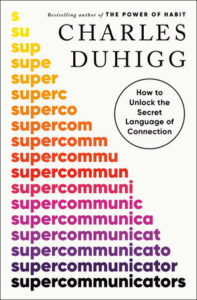 Get better at connecting with people.
Get better at connecting with people.
Charles Duhigg’s new book Supercommunicators: How to Unlock the Secret Language of Connection offers practical ways to hold deeper, more meaningful, less conflict-driven conversations.
Given the divisiveness in small towns and rural communities today, these are essential community-building skills.
It’s also relevant for rural small business owners who face a variety of communication challenges with customers, employees, suppliers, community members and more.
Duhigg’s name may be familiar. He also wrote The Power of Habit, another book I found useful.
In Supercommunicators, he covers different types of conversations we have: practical, emotional, and social. Usually, we don’t even think about what kind of conversation we’re having, and that leads to the kinds of problems we’re all used to. Duhigg provides insights on how to recognize and adapt to each type of conversation.
The book’s advice on everyday conversations is particularly useful. This advice is practical and not too hard to remember. Simple graphics make concepts ultra clear. The advice on social and belonging conversations is trickier. When we’re talking about who we are and how we fit or don’t fit in, more care and more guidelines are needed. It starts to feel like a lot, but it’s better than pretending we already know all about it.
The biggest issue I had with the book is the complicated structure within sections. Duhigg often starts a story, then interrupts it with another story, then interrupts that with explanation. It makes it hard to keep track of all the narratives at the same time if you’re not reading large sections in one sitting. Despite this, Duhigg does a good job of getting the practical information across, and the illustrations make the book engaging and informative.
I received an advance copy of the ebook at no cost from the publishers via NetGalley. These are my honest opinions. The book’s publication date was set for Feb 2024.
How might we put ‘unity’ back in community?
Communities are the foundation of our society, and their strength and success lie in the unity of its members. Yet, often at the heart of so many communities is disunity. As a community coach, I collaborate with rural leaders to build local capacity and engage community members in working on local priorities so their community […]
Communities are the foundation of our society, and their strength and success lie in the unity of its members. Yet, often at the heart of so many communities is disunity.
As a community coach, I collaborate with rural leaders to build local capacity and engage community members in working on local priorities so their community can thrive. One of the most common topics that comes up as the groups are planning for future outcomes is their desire for unity with other community leaders. They recognize disunity as a polarizing barrier to their success as they strive to engage other individuals, organizations, or elected officials in creating a thriving community. When addressing disunity, one challenge of being a community coach is feeling the need to “fix it” because as an outsider it’s often easier for me to recognize those blind spots. However, my role is to empower individual leaders to own their failures and create solutions for putting unity back into the community.
What causes divisiveness?
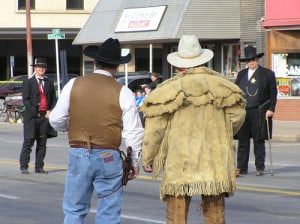
Do personal disagreements turn into community standoffs? Photo by Becky McCray
So, what is it that brings disunity to a community? Below is a list of some common culprits:
- Lack of trust between leaders and community members
- Resistance to change
- Leadership immaturity
- No defined purpose or vision
- Inconsistency in meetings
- Unfulfilled promises
- Competition for resources or power
- Unclear communication methods
- Self-centered interests
- Burnout and stress
- Allowing events to railroad relationships
To address disunity as a polarizing barrier to developing a thriving community, it’s essential to name the specific causes at play from the list above and implement strategies to mitigate them. Below is a list of improvements that can be made by individuals, organizations, or elected officials to find more unity in their community:
Open Communication
The foundation of any united community is open and honest communication. Offer encouragement and opportunities for community members to express their thoughts, ideas, and concerns. Create platforms for discussion, whether through community meetings, online forums, or social events. Effective communication ensures that everyone’s voice is heard, fostering an inclusive atmosphere where decisions are made collectively.
Include Everyone
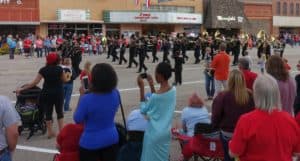
When you include everyone, what will that look like? Photo by Becky McCray
Diversity is a strength, and inclusivity is key to building unity. Celebrate and respect the differences among community members, including cultural, social, and economic diversity. Develop programs that actively involve people from all backgrounds, ensuring that everyone has a place at the table. When people feel valued and heard, unity naturally follows.
Purpose and Goals
A united community needs a clear purpose and shared goals. These goals can be as simple as improving neighborhood safety, organizing cultural events, or addressing local environmental issues. When community members work together towards a common purpose, it strengthens their sense of unity. Ensure that the goals are transparent, achievable, and reflect the diverse needs and aspirations of your community.
Connect through Collaboration
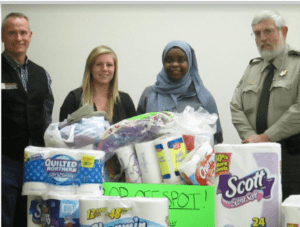
How can you help people work together across groups? Photo via Deb Brown
Create opportunities for collaboration within your community. Encourage community members to form teams and work together on projects, whether it’s a local garden, community signage, or organizing social events. Collaborations not only improve the quality of life but also foster a powerful sense of belonging and shared responsibility.
Empower and Engage
Empower community members to take ownership of their shared spaces and challenges. When individuals feel a sense of responsibility for their community, they become more invested in its well-being. Encourage people to take on leadership roles, participate in local governance, and contribute to the betterment of the community.
Inspire Learning
Promote education and awareness about programs or initiatives within your community and from resources outside the community. When community members are well-informed, they are more likely to respect and support each other’s values, leading to a stronger sense of unity.
Celebrate Achievements
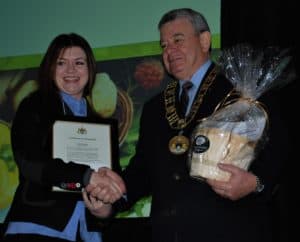
Find more ways to celebrate more successes in your community. Photo courtesy of Norfolk County, Ontario.
Celebrate the milestones of your work and recognize the efforts of individuals and groups who have contributed to the betterment of the community. Regularly holding events and celebrations not only instills a sense of community pride but also reinforces the feeling of unity and camaraderie.
Conflict Resolution
No community is without its conflicts. The key to maintaining unity lies in how these conflicts are managed. Establish an impartial conflict resolution process that allows for disagreements to be addressed constructively. Mediation and open dialogue can help community members find common ground and reach mutually acceptable solutions.
Commitment to Planning
Keeping unity in the community is an ongoing process that requires long-term planning. Establish a vision for the future and work collaboratively to achieve it. Encourage community members to stay engaged and commit to building a strong, unified community for generations to come.
Building unity in a community is a transformative process. By following these essential steps, your community can create a sense of belonging and togetherness that will empower its members to thrive and make a positive impact on society.
Shop Local tools: Easy Editorial, Letter to the Editor template to copy
Promote local shopping with a letter to the editor or editorial Step by step instructions Ready to promote local shopping to more of your community? Try an editorial or a letter to the editor. You can submit this to your local newspaper, share it in any organization newsletters, and post it on social media! Step […]
Promote local shopping with a letter to the editor or editorial
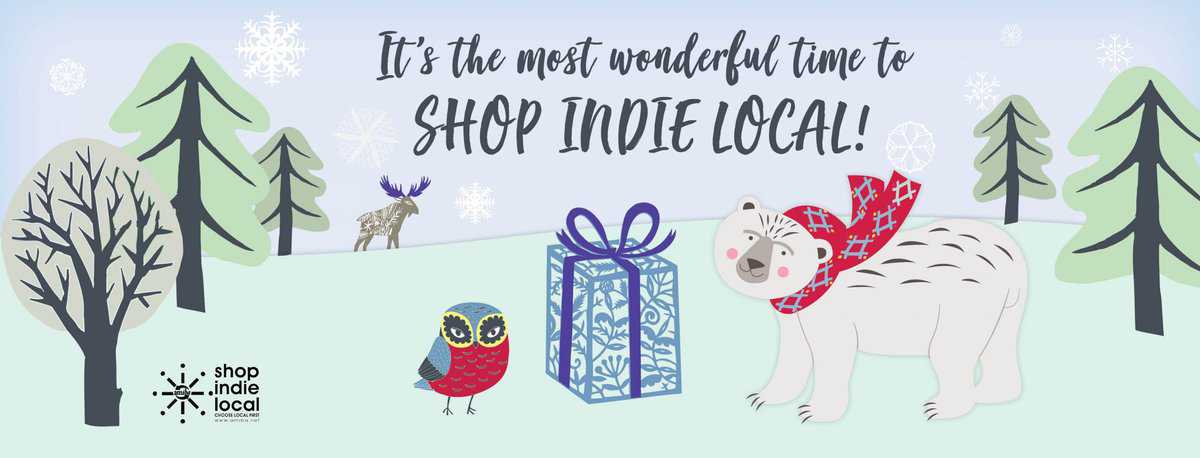
Step by step instructions
Ready to promote local shopping to more of your community? Try an editorial or a letter to the editor. You can submit this to your local newspaper, share it in any organization newsletters, and post it on social media!
Step 1. Easily grab these 3 simple numbers for your state or territory.
If you’re in the USA, go to Small Business Profiles at the Small Business Administration. Scroll down and click on your state or territory. You’re looking for these numbers:
- Number of small businesses
- Percentage of small businesses
- Percentage of employees
If you’re in another great country, try searching for each stat, like “Number of small businesses” plus the name of your state, territory or most relevant region. I just tried “number of small businesses New Zealand” and found out that there are 546,000 small business that are 97% of all businesses in New Zealand, plus they employ 29.3% of all employees.
Hot tip: Keep the PDF or website for your data open in a tab on your browser or on your phone, and it will be simple to find the numbers to fill in the template.
Here’s an example for the State of New Mexico:
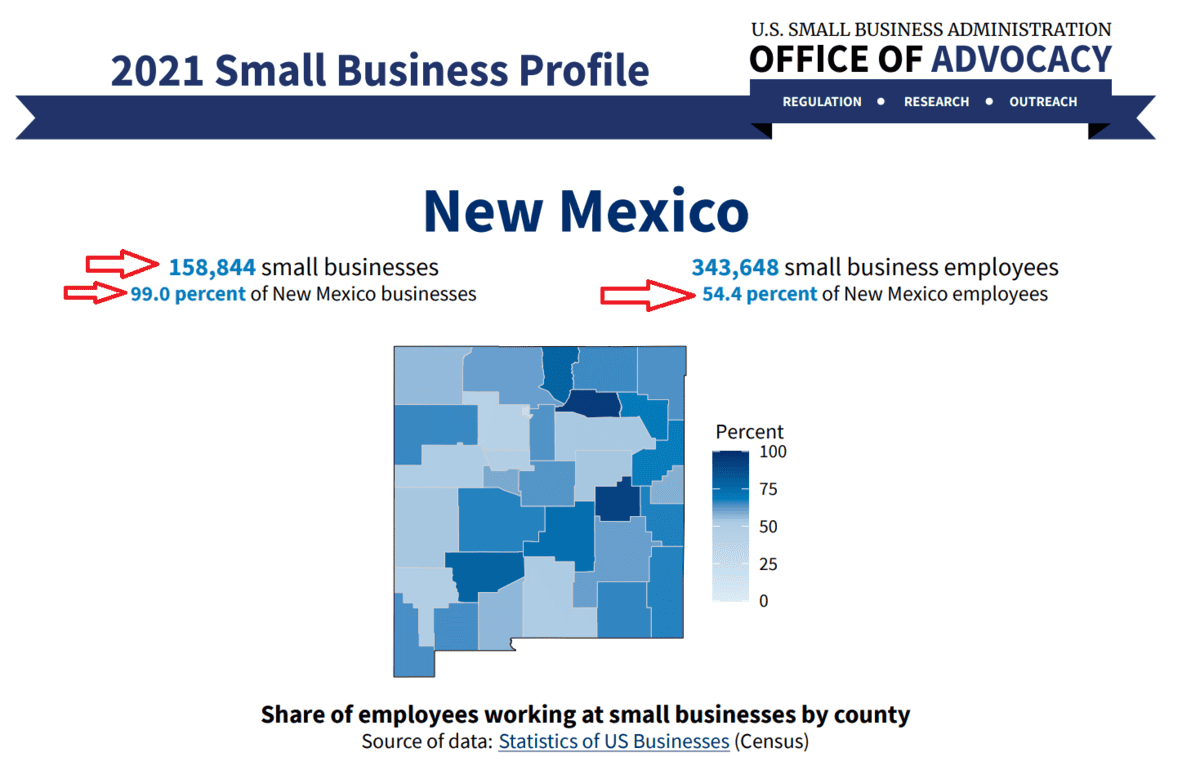
Step 2. Copy the template below to your favorite editor like Google Docs, Word, or even the notes app on your phone!
This template was provided by the Shop Indie Local promotion of the AMIBA – American Independent Business Alliance. They are a great resource for supporting local shopping all year long.
The Google Docs version of the template is here. (That link is subject to change in future years. If it’s no longer working, just copy the text from below.)
Step 3. Look for the sections in brackets {LIKE THIS} and fill them in.
You already know your state or territory name, and you just picked up those 3 simple numbers about small businesses. Just plop them into the note or document to customize it.
Step 4. Change any wording to make it sound more like you!
It’s ok to reword it, add something, or delete stuff that you would never say. The more personal you can make it, the better!
Don’t want to change a thing? That’s fine, too.
Step 5. Add a local story, or tell about a favorite local business.
The perfect place to do this is right after “entrepreneurial spirit.” Just start a new paragraph, and include a couple of sentences like this:
Holder Drug is the perfect example in our town. Not just the pharmacy, but also their amazing soda fountain! They’ve supported my family and yours for better health for generations, and they’re always one of the first donors to any local project.
Step 6. Submit it to a local newspaper.
Just email it to the editor or anyone you know at the paper. Check their website or a recent paper to find the email address. Or text a friend and ask!
Bonus points: Print it in organization newsletters.
If you belong to any club, church or organization, submit this for the next issue of the newsletter or email newsletter.
Double bonus points: Share on social media!
One super effective way to post on social media is to actually print out the letter on paper, sign it by hand, then post a photo of it to Instagram or Facebook with all the best local hashtags. And you can post the text in the comments. Multiply it by cross posting to local shopping or buy/sell groups on Facebook.
Don’t forget the #ShopIndieLocal hashtag!
That’s it! Ready to go? Here’s the template:
DRAFT Letter to the Editor Template: Shop Indie Local
In {ADD YOUR STATE/TERRITORY}, we pride ourselves on our independent thinking, ingenuity, and self-reliance — qualities reflected in our entrepreneurial spirit.
According to the Small Business Administration’s latest Small Business Profile, our state{OR TERRITORY} is home to more than {ADD NUMBER} small businesses (employing fewer than 500 people), comprising {ADD PERCENTAGE} percent of all {ADD YOUR STATE/TERRITORY} businesses.
Our small businesses also provide the most significant source of jobs across the state{OR TERRITORY}, employing {ADD EMPLOYEE PERCENTAGE} percent of all private-sector workers, compared to an average of 48 percent nationally.
Whether you run a business or not, we all have an essential role to play in supporting entrepreneurial success and community wealth. As many of us look to share gifts with friends, family, and coworkers, we also have the opportunity to give a gift to our community. When making holiday purchases, we ask you to “Shop Indie Local” and choose to spend your dollars at locally owned and independent businesses.
Why Shop Indie Local?
When you spend your dollars at locally owned retail businesses, more money returns to your local economy than if you spend that same dollar at a chain store. According to Civic Economics, when you spend a dollar at an independent business, about 48 cents returns to your local economy. (Spend it at a chain store and only 14 cents return; spend it at an online giant and only pennies return.) That 48 cents recirculate through a local economy, generating ripple effects that strengthen jobs, charitable contributions, and community prosperity. Capitalizing on this local multiplier effect is key to creating jobs and wealth in our community.
On the flip side, purchasing from Amazon or other remote online retailers provides virtually no economic benefit to our community. The American Independent Business Alliance calculates that 1 percent of the cost of an online purchase will go back into your community — only if the delivery person is a local resident.
Local, independent retail businesses help employ many more people than just those on the sales floor. They’re more likely to bank with your local banks and buy from other local businesses compared to absentee-owned companies. They’re also more likely to hire local service providers like accountants, graphic designers, sign-makers, webmasters, and various skilled positions — jobs for aspiring entrepreneurs.
Local non-profit organizations depend largely on contributions from local businesses. This support builds relationships that cement commitment to civic institutions like schools, churches, and fraternal leagues that aid economic prosperity, community cohesion, and trust.
If most of us shifted even one or two more purchases to independent, community-based businesses this season, we would create dramatic, positive changes in our local economies and help induce new jobs in our state{OR TERRITORY}.
So do yourself — and our community — a favor this year by shifting more of your spending to your local merchants, service providers, artisans, and locally owned and independent businesses. Along with helping your neighbors and community, you may just find that the Shop Indie Local spirit turns holiday shopping into a far more relaxing and enjoyable experience: one that rewards both you and your community.
{SIGN YOUR NAME HERE}
Shop Indie Local Week and Holiday Season, it’s way more than Shop Small Saturday
Guest post by Jen Risley, AMIBA Thank you for your commitment to building the local economy movement! Wishing you an inspiring Shop Indie Local Week with the entire community. My cat Shamu (above) can’t wait for Plaid Friday! One practical step: #ShopIndieLocal It doesn’t have to be overwhelming. Any local business or group can start by sharing social […]
Guest post by Jen Risley, AMIBA
Thank you for your commitment to building the local economy movement!
Wishing you an inspiring Shop Indie Local Week with the entire community. My cat Shamu (above) can’t wait for Plaid Friday!
One practical step: #ShopIndieLocal
It doesn’t have to be overwhelming. Any local business or group can start by sharing social media posts announcing your plans and adding #ShopIndieLocal to your posts.
Not just Saturday: Plaid Friday through Giving Tuesday
The week after Thanksgiving is a super busy one for the Shop Indie Local movement as we celebrate Plaid Friday, Small Business Saturday, Artists Sunday, Cider Monday, and Giving Tuesday.
Invite Independent Businesses to Plaid Friday
From TLC Monadnock: We invite businesses to serve as Plaid Friday Hubs in the Monadnock Region, NH. Back in 2009, what started with three hubs has grown to over thirty each year. View our invitation and adapt it to work for you!
Artists Sunday: Celebrating Local Artists, Creators, and Performers
From Artists Sunday: Artists Sunday, falling on November 26 this year, is the celebrated day after Thanksgiving dedicated to supporting local artists, creators, and performers. This year marks the fourth annual Artists Sunday, a unique shopping experience featuring over 4,000 professional artists and more than 500 non-profit art organizations, municipalities, and commercial entities across the nation.
“This Artists Sunday, let’s come together to celebrate and support the artists in our communities. It’s a day to fill our lives with beauty, creativity, and joy,” states Christopher V. Sherman, Executive Director of Artists Sunday
Why Cider Monday Matters
Celebrate Cider Monday to bring attention to the effects of online sales on your community. You love buying local, but the next thing you know … CLICK, you purchased that blender online from a business far from your community. It’s so easy! And your one purchase won’t really make a difference… or will it?
Unleash Generosity on Giving Tuesday
From Giving Tuesday: Whether it’s making someone smile, helping a neighbor out, or showing up for an issue or people we care about, we each have something to contribute. Identify your gifts, pick a cause that gets you fired up, and give back. Each seemingly small act turns a ripple into a wave of good, transforming society and building the world we all want to live in.
Get more ideas, graphics and support
When you become a partner for the holidays, you’ll join 150 Shop Indie Local Holiday Campaign partners from 42 states, including SmallBizSurvival! You’ll also find downloadable logos and other images. You can adapt our templates in Canva including Square Images, Banner Images and Mobile Video. There’s no deadline, and it’s definitely not too late to join.
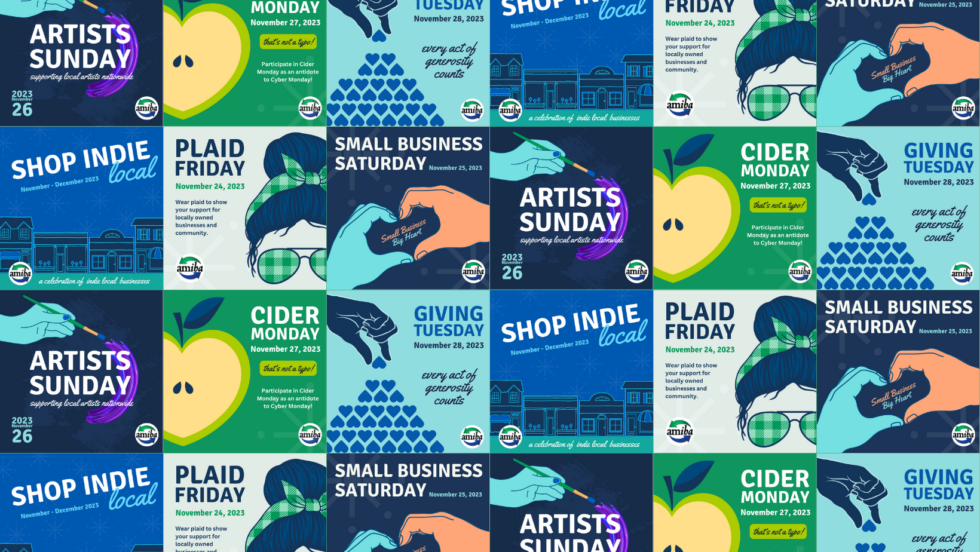
Get graphics and idea support from AMIBA Shop Indie Local.
Expand your November and beyond:
Native American Heritage Month
From First Nations Development Institute: Celebrate Native American Heritage Month with First Nations! This month and all year, we recognize and honor Native contributions, history, culture, and ingenuity. We’ll be sharing ways to support Indigenous leaders, authors, creators, and communities all month, including:
- How to be an ally to Native Americans by reclaiming Native truth and challenging stereotypes.
- Resources to learn about Native American heritage, culture, and issues.
- How to support Native-owned businesses in your holiday shopping.
- Opportunities for your donation to make the largest possible impact for Native communities.
Neighborhood Toy Store Month
From ASTRA: Local toy stores aren’t just places where families shop; they are centers of creativity, imagination, and learning.
Learn more: Neighborhood Toy Store Month
Join the Choose Indie Local Movement for the next year
Get ready for year-round ideas and support with next year’s Choose Indie Local campaigns. Our Choose Indie Local program inspires and supports community members to boost the ripple effect of economic and community benefits we receive when we spend and invest dollars at locally owned businesses. Let’s make ripples!
To give us a jump start, we’re announcing our 2024 campaigns today.
- Choose Black-Owned
- Choose Indie Sustainable
- Move Your Money: Bank Local, Invest Local
- Bicycling Means Business
- Choose Indie Pride
- Independents Month
- Eat Indie Local
- Choose Indie Art
- Shop Indie Local
Think of the list above as a menu of options. Choose the campaigns that align with your overall goals and sign on to participate in one, two, or all nine.
What partners receive:
You’ll receive a list of resources to help you establish your goals and leverage each theme you sign up for.
We’ll list your business/organization as a partner on our campaign webpage(s).
One month leading up to the campaign and weekly once our campaign starts, you’ll receive updates to inspire you and keep your campaign momentum strong.
Sign onto Shop Indie Local for 2024 .
Subscribe to SmallBizSurvival for more Shop Indie Local updates throughout the year.
